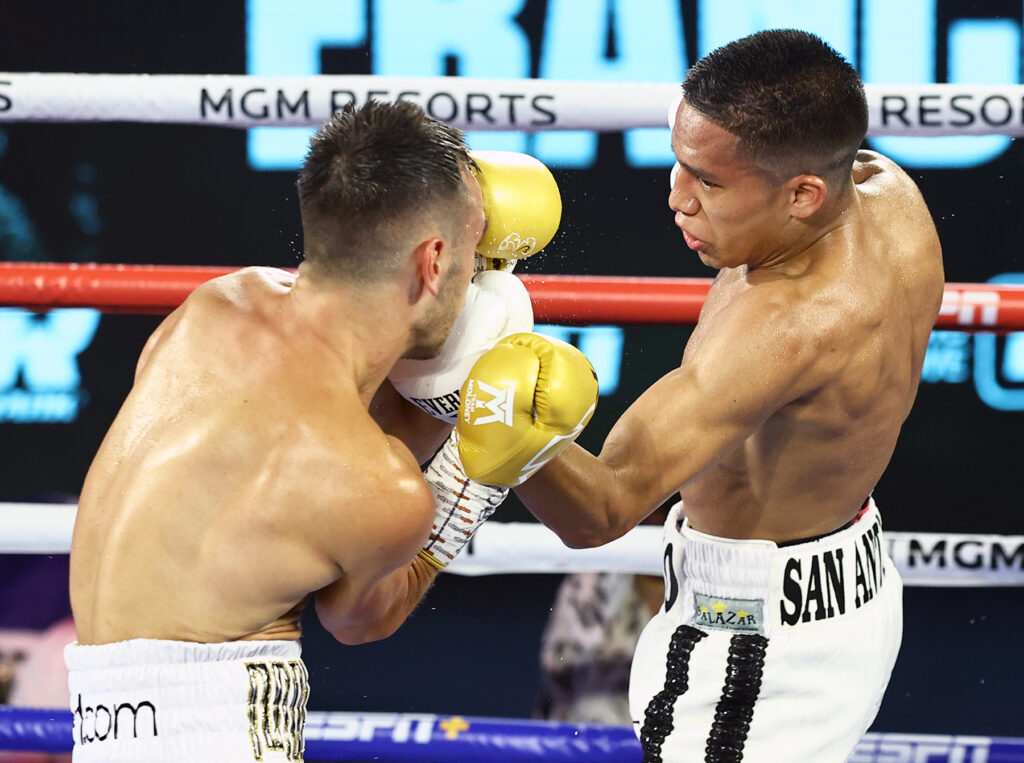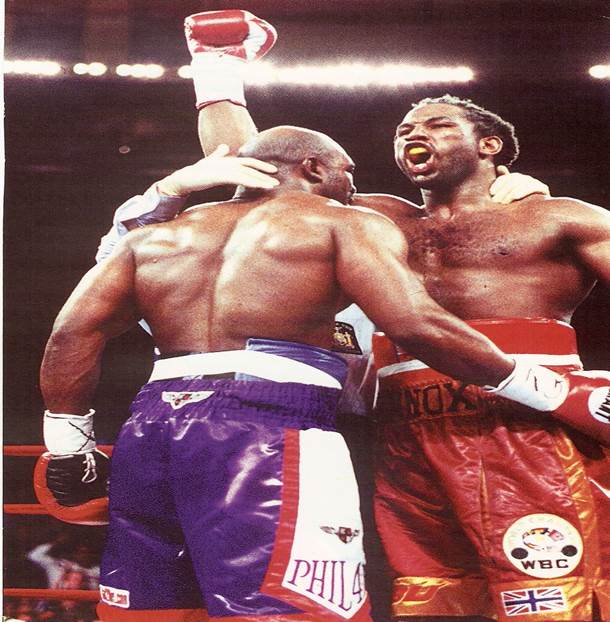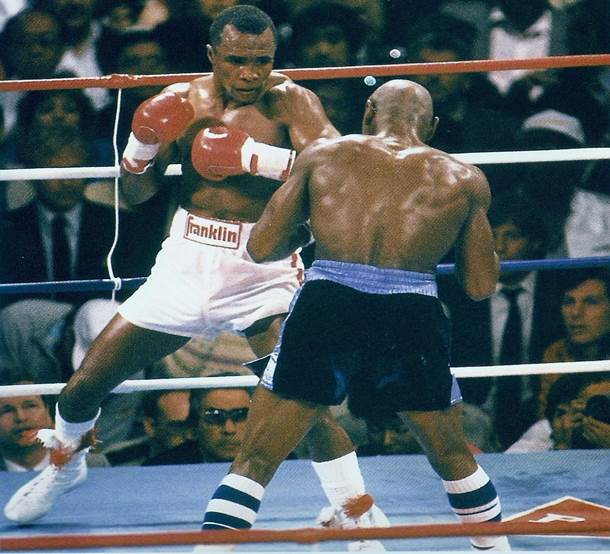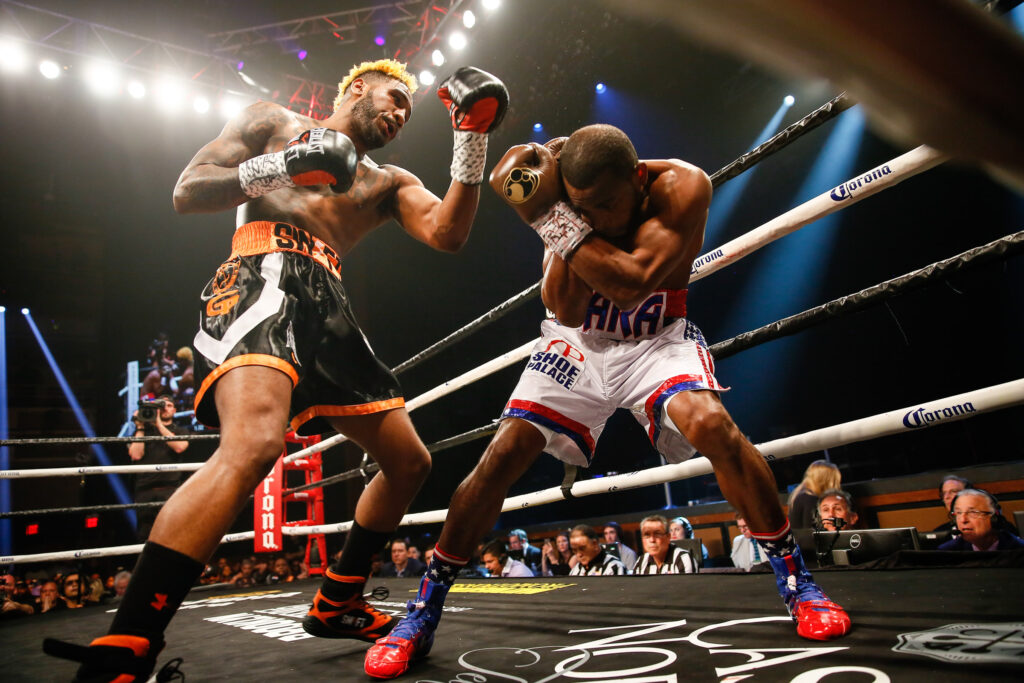IBHOF inductee Graham Houston looks back at some of the notable occasions where a gargantuan, last round effort has saved the day for a fighter with that little bit extra left in the tank.
You’ve probably heard it many times. The fighters are in their corners waiting for the bell to sound for the final round. A trainer will say to his boxer: “It’s all on this round…” Or: “Last round coming up — leave it all in the ring!”
There are variations on the theme. But what the trainer is telling the fighter is this: “This fight could be close. We don’t know how the judges are seeing it. Make sure you win this round.”
That advice has been crucial in many fights. Winning the last round in a fight that could be in any way close is very important. We saw it this week when Joshua Franco swept the last round on the scorecards to take the 115-pound title from Andrew Moloney on a unanimous but so-close decision. If Moloney had won the 12th, the title would have gone back to Australia with him. That’s how close this fight was on the judges’ cards.

from Andrew Moloney. Photo: Mikey Williams, Top Rank.
Now, you might hear the argument: “Why is it so important to win the last round? Why is it any more important than winning, say, the first round?”
Okay, here is why.
Say we have a 12-round title bout. In the early to middle rounds, a judge has some leeway.
It is understandable if, with several either-way rounds, a judge doesn’t feel comfortable having one boxer racing into a wide lead. (And even though a judge hands in his/her scoring slip after each round, experienced arbiters will have a pretty good idea how their scores are taking shape.)
If the rounds are closely contested, a judge might not wish to have one boxer building an insurmountable lead on points. So it isn’t unreasonable for a judge, having given one boxer the benefit of the doubt in a couple of rounds — the sort of rounds that fairly could have gone to either boxer — might give the other boxer the nod in yet another tight round.
I’m not saying that this happens, but it seems plausible and perfectly understandable.
So, with rounds going back and forth, it’s as if everything builds to a crescendo as the final round approaches.
Now, with three minutes to go, it really is all on the line. That final round can decide the fight, whether it’s going to be a win, a loss or a draw.
There is such a thing as a boxer. seemingly in front, deciding to box his way home in the last round. Playing it safe, as it were. Some cornermen will advise this: “The fight’s yours. Don’t take any chances.”
However, I’m not sure this is always the best advice. Yes, it is in a fight such as, say, Sergio Martinez vs Julio Cesar Chavez Jr, when Martinez has obviously been outclassing Chavez, who needed a knockout to win (and did indeed get a last-round knockdown).
In many fights, though, it surely isn’t wise to assume anything. Many observers thought Manny Pacquiao was too far in front on points to lose to Timothy Bradley in their first meeting. Wrong on that. Bradley dug down, won the final round on all three judges’ cards and pulled off the upset on a controversial, split decision.
Take the first meeting between Lennox Lewis and Evander Holyfield. It was the widely held opinion that Lewis was too far ahead to lose after 11 rounds. Not so. Lewis was, in fact, very close to blowing his heavyweight title on the scorecards. His trainer, the great Emanuel Steward, sensed this. “You lost that goddammed round because you making him miss but you ain’t doing shit!” Steward told Lewis in the corner at the end of the 11th. “You’ve gotta come back with something! You’ve gotta be a bit more aggressive.”
Lewis heeded Steward’s advice and had his best, most assertive round of the fight in the 12th. All three judges gave Lewis the round. It didn’t give Lewis the win, but it allowed him to get out of Dodge with a draw. (OK, a draw that should have been a win in the view of most.)

Occasionally, a corner’s advice to a fighter to close out the bout strongly can turn out to be unwise counsel. We think of the first fight between Julio Cesar Chavez and Meldrick Taylor. Chavez had been the aggressor and had inflicted damage. Taylor’s eyes were swollen and closing, his nose bloody. Blood showed inside his mouth. He looked beaten up. But Taylor had often boxed superbly and he piled up a lot of points.
As Taylor sat on his stool waiting for the last round to begin, there was concern in his corner. We now know that two judges had Taylor comfortably in front. But his corner didn’t know that. “You need this round!” manager Lou Duva told his fighter before the start of the 12th. Meanwhile, HBO’s unofficial scorer, Harold Lederman, had Taylor dominating the fight on points, 108-101. “I think he’s on his way to a unanimous decision,” Lederman told HBO colour commentator Jim Lampley in the minute’s break between the 11th and 12th rounds.
A concerned Sugar Ray Leonard, HBO’s expert analyst on the night, didn’t like the warrior mentality that Taylor showed in that last round. “Play it safe and box,” Leonard suggested. (Words that, of course, Taylor couldn’t hear — not that he would necessarily have followed Sugar Ray’s counsel).
If only Taylor had indeed played it safe and just tried to move, jab, clinch — if he had just focused on getting through the final three minutes — he would surely have won the fight. But then, maybe Taylor was so tired and battered that he was fighting on instinct in that final round. Even if Lou Duva had urged him simply to stay out of trouble, maybe Meldrick would have been unable to follow that advice.

away in the final seconds against Julio Cesar Chavez (right). Photo: WBC.
Generally, though, it makes sense for a boxer to leave nothing to chance and to go for the strong finish, as Franco did against Moloney.
Here are just five (of many) fights where it all rested on the final round.
Larry Holmes W15 Ken Norton – Las Vegas, June 9, 1978.
After 14 exciting rounds, the judges had it dead-level in the Holmes vs Norton bout for the WBC heavyweight title. The 15th and final round was the decider. Judge Lou Tabat gave the 15th to Norton but judges Harold Buck and Joe Swessel gave the round — and with it, the fight — to Holmes. The judges agreed in 12 of the 14 completed rounds. That reflected the fight’s pattern, with each man taking it in turns to assume control. The final round was a tough one to score. Norton seemed to be in command for the first two minutes of the round. A right hand sent Holmes’ gumshield spinning to the canvas. But Holmes surged back, landing right hands and knocking back Norton’s head with a left uppercut. And, with both men looking nearly exhausted, it was Holmes’ closing spurt that caught the eye of two of the judges. “Norton seemed to win the 15th round clearly,” writer Jack Hawn (who had Norton ahead by one point) wrote in the Los Angeles Times.
Sugar Ray Leonard W12 Marvin Hagler – Las Vegas, April 6, 1987.
Forget the scorecard of Mexican judge Jose Juan Guerrero, who had Leonard winning 10 of the 12 rounds. This was a close fight that was to be decided on which boxer won the last round. Judge Dave Moretti had Leonard one point ahead going into the 12th while judge Lou Filippo had Hagler a point in front. If Leonard was to win the fight and the middleweight title, he needed the last round on either the Moretti or Filippo card. Judge Moretti scored the 12th in favour of Leonard, thus giving him the verdict by a score of 115-113, while judge Filippo went the other way, with Hagler taking the 12th and also the decision, 115-113. The verdict was hotly disputed. Hagler pressed forward but Leonard was flashier. At one point in the 12th, Leonard unleashed a burst of something like 20 punches in rapid succession, too fast to count. It wasn’t a damaging sequence, really nothing more than a furious flurry, but it looked good — and it might have stolen the round, and the fight, for Sugar Ray.

middleweight legend Marvin Hagler (right) in April 1987. Photo: WBC.
Shane Mosley W12 Oscar De La Hoya – Los Angeles, June 17, 2000.
The welterweight title fight between Los Angeles rivals De La Hoya and Mosley lived up to all expectations. It was simply an excellent fight. There was skilled boxing, sharp punching, shifts of fortune. Coming out for the last round, the decision was, as they say in the US, up for grabs. Judge Lou Filippo had Mosley ahead by 106-103, so Sugar Shane basically couldn’t lose on Filippo’s card unless he got stopped. Judge Marty Sammon had De La Hoya up by a point, Pat Russell had Mosley one point ahead. The stage was set for a rousing finish. From ringside I had Mosley up, 105-104, but felt he needed to finish the fight powerfully to make sure. Mosley seemed to sense this himself because he staged a blazing finish, clearly outpunching and outspeeding De La Hoya to take the 12th round on all three judges’ cards. “I wanted to leave my mark in the 12th round,” Mosley told the post-fight press conference. “I wanted to show the world who was the stronger and better fighter.”
Canelo Alvarez Draw 12 Gennady Golovkin – Las Vegas, September 16, 2017.
Judge Adalaide Byrd had an off night, making Canelo the winner by 118-110. The decision in this middleweight title bout rested on the last round. Judge Dave Moretti saw Golovkin in front by 106-103; Don Trella had Golovkin leading by 105-104. So, Golovkin needed to win the 12th on the Don Trella card to sew up the decision. But GGG had been fading late in the bout. Canelo, coming on strongly, swept the 10th and 11th rounds on the scorecards. And it was the younger, stronger Canelo who had the big last round. “Abel Sanchez [Golovkin’s trainer] told Triple G ‘Don’t let him rest’ — but Canelo’s not trying to rest!” analyst Max Kellerman exclaimed on the HBO PPV broadcast. In a hard-fought final round, Canelo seemed to land the clearer scoring blows, including a couple of nifty right uppercuts. “Could these moments decide the fight?” Max Kellerman asked. Yes, they could. Canelo captured the last round on all three judges’ cards to pull out a debatable draw, thus setting the stage for a rematch.
against Gennady Golovkin in their first encounter.
Jarrett Hurd W12 Erislandy Lara – Las Vegas, April 7, 2018.
Of all the big last rounds in recent memory, none topped the absolutely storming finish that earned Jarrett Hurd a split decision over Erislandy Lara to win the IBF 154-pound title. Younger, bigger, stronger, Hurd was the relentless aggressor, but Cuban Lara did some crisp scoring from out of his southpaw stance. Hurd seemed to be slowing down as the fight went into the late rounds. Lara swept the 10th and 11th rounds. Hurd, behind by one point on two cards and trailing by three points on the third card, needed to produce something special. Hurd did just that. He dug deep within himself and simply overpowered Lara in the 12th. A right uppercut set up Lara for a left hook that sent the Cuban boxer to the canvas for the only knockdown of the contest. Lara, now cut over the right eye, gamely fought back after taking the eight count but Hurd would not be denied. It was a big finish for the ages — and it won Hurd the fight.

and take the spoils. Photo: Stephanie Trapp/Showtime.
Main image: Stephanie Trapp/Showtime.